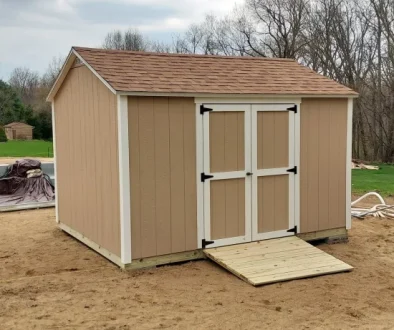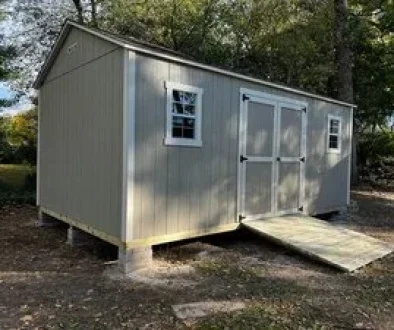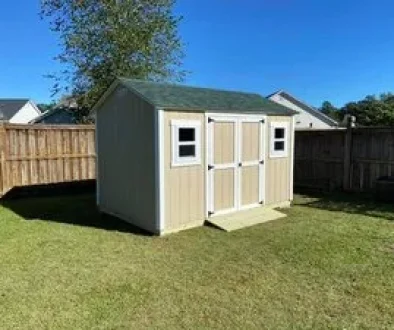Find the Best Foundation for Your Amish Shed
When it comes to setting up your Amish shed, the foundation is key. Many shed owners face two big problems: the hard work of preparing the site and the many choices for amish shed foundation. Think about spending hours looking up information and still ending up with the wrong foundation. Or if you find out that your shed is uneven due to unlevel ground would be worse. These problems happen a lot, but with the right help, you can build a strong foundation that lasts for years.
Best Foundation for Amish Sheds
Choosing the best foundation for your on-site Amish shed really depends on what you need and the conditions of your site. Overall, a concrete slab or gravel foundation are two options that stand out. Concrete provides a strong, stable base that’s great for heavy use, while on the other hand, gravel provides excellent sewerage and flexibility.
With that said, both options have their own advantages. But keep some other factors in mind like your soil type, climate, and budget. For a better understanding of these shed foundations and tips on how to pick the best one for you, just keep reading.
Why a Good Foundation is Crucial
Overlooking the importance of a solid and stable foundation directly impacts the shed’s durability and performance. A well-constructed foundation ensures that your shed remains level, secure, and functional over time.
Ensuring Longevity and Stability
A strong foundation is like the backbone of your shed. It keeps everything level and secure, no matter what the weather does. For instance, a concrete foundation offers excellent strength, handling heavy loads and adapting well to changing conditions. On the other hand, if there is no proper foundation, you might face problems like uneven floors, doors that don’t align correctly, or even major structural issues.
Preventing Common Problems
Choosing a foundation that is not suitable for your Amish shed can lead to several issues. You can use durable concrete slabs but they can crack if there is ground movement or is not properly installed. If the drainage needs to be handled well and you don’t pay attention to it, moisture can cause serious damage and expensive repairs.
Consequences of a Weak Base
If you choose a gravel foundation but don’t get the drainage right, water can collect and erode the base which can make your base weak.
By selecting the right foundation, you can avoid these problems and improve how well your on-site shed performs. Investing in a strong foundation means your Amish shed will stay reliable and valuable for years to come.
Types of Foundations for Amish Sheds
You want your shed to have a long life span and to be stable then you must choose the right foundation for your Amish shed. Let’s discuss about the a few common types with their pros and cons
Concrete Foundation
Solid and tough, concrete bases are great for Amish sheds. They handle heavy loads and rough weather like a champ. They are more costly than others but prove their worth by being low maintenance and durability. If you want a storage shed that stays put for years, concrete’s your best bet.
Pros and Cons of Concrete Foundation:
- Strength and stability: Keeps your shed level and secure
- Durability: Stands up to harsh weather and heavy loads
- Low maintenance: Requires little upkeep
- Higher cost: More expensive to install than other options
- Time-consuming: Needs time to cure and set, which can slow down your project
- Potential cracking: Improper installation or ground movement can lead to cracks over time
Gravel Foundation
Gravel’s a smart choice for shed bases. It’s budget-friendly and lets water drain away easily. You can quickly adjust it for different shed sizes too. While not as sturdy as concrete, it’s great for many standard sheds and won’t break the bank.
Pros and Cons of Gravel Foundation:
- Flexible and adjustable: Easy to modify for different shed sizes and shapes
- Good drainage: Helps water flow away from the shed
- Cost-effective: Generally cheaper and quicker to install than concrete
- Less stability: May not be as solid as concrete, especially for larger sheds
- Debris collection: Can gather leaves and other debris, requiring occasional cleaning
- Settlement issues: Gravel may shift over time, needing re-leveling
Wooden Foundation
Wood foundations are eco-friendly and versatile for Amish sheds. They’re easy to construct and you can move them if needed. They’re cost-effective and great where you don’t want to disturb the ground much but they need more regular care than concrete, . Just remember to use treated wood to make them last longer.
Pros and Cons of Wooden Foundation:
- Eco-friendly: Uses natural materials, often a sustainable choice
- Easy assembly: Simpler to build and adjust compared to concrete
- Portable: Can be taken apart and moved if needed
- Less durable: Can be vulnerable to rot, pests, and weather damage
- Maintenance: Needs regular checks and treatments to prevent decay and pest problems
- Weight limitations: Not ideal for very heavy structures
Paver Foundation
Want a shed base that looks good and works well? Try pavers. They’re strong and you can get creative with designs. Pavers cost more than gravel but less than concrete. They’re perfect if you care about both function and style for your Amish shed.
Pros and Cons of Paver Foundation:
- Versatile design: Allows for various patterns, enhancing your shed’s appearance
- Moderate cost: Generally more affordable than concrete but pricier than gravel
- Straightforward installation: Relatively easy to install with minimal ground prep
- Settling: Pavers may shift over time, requiring occasional adjustments
- Weed growth: Gaps between pavers can allow weeds to sprout, needing regular maintenance
Load-bearing capacity: May not be as strong as concrete for very heavy sheds
Stop Guessing – Calculate Your Perfect Shed Budget!
Our effortless buying process makes it easy to customize your storage shed.
How to Choose the Right Foundation
To make it last, picking the right foundation for your Amish shed is key. You want to know how to choose the right foundation for your Amish shed?To help you make an informed decision here’s a guide
Soil Type: Impact on Foundation Choice
Your soil type affects your choice. Clay soil might need a deeper foundation. Sandy soil works well with gravel. Loam is great for most foundations. Rocky soil? Try pavers or wood. Understanding your soil type and its characteristics can help you choose a foundation that will remain stable and secure.
Climate: How Weather Conditions Affect Foundation Stability
Climate and weather conditions are critical factors in foundation selection. The local climate can influence the type of foundation that will provide the best support for your Amish shed.In cold places, watch out for frost. Concrete with good insulation helps. Wet areas need good drainage, so gravel can work well. For dry spots, a deep concrete base keeps things steady.
Shed Size and Weight: Importance in Foundation Selection
To determine the appropriate foundation type and weight of your Amish Shed matters a lot. Larger and heavier sheds require stronger foundations to support their weight and prevent settling or shifting.
Small sheds can use gravel or wood bases. Medium ones do well with concrete or gravel. Big, heavy sheds need strong concrete foundations.
Matching the foundation type to the shed’s size and weight will ensure optimal support and prevent future structural issues.
Professional Advice: Consult a Professional for Foundation Installation
Sometimes doing it yourself works, but getting a pro’s help can be smart. They’re great for tough spots, big sheds, or when you need permits. Pros make sure your foundation is done right. Getting expert advice gives you peace of mind, knowing your shed’s base is solid and will save you time and money.
When picking your Amish shed foundation, think about your soil, weather, and shed size. Don’t forget to consider expert help too. Plan carefully now, and your shed will stay strong and useful for years to come.
Shed Foundation Headaches? Effortless-Shed Delivers Stabilit
Confused about shed foundation? At Effortless-Shed, we simplify the process of selecting the right foundation for your on-site Amish shed in Michigan. We know the importance of a solid base for a strong foundation for your shed’s longevity and functionality. That’s why we offer expert consultations to help you choose the perfect foundation for your unique needs.
Don’t settle for a DIY disaster! Our experienced team will evaluate your soil type, climate, and shed size to recommend the best foundation solution, be it concrete, gravel, wood, or pavers.
Effortless-Shed offers:
- Expert Foundation Recommendations: We’ll guide you through foundation options best suited for your specific project.
- Professional Installation: Our experienced crew ensures your foundation is level, stable, and ready for your Amish shed.
- Peace of Mind: Relax knowing your shed rests on a solid foundation built to last.
Don’t gamble with your shed’s stability.
Building a solid foundation is crucial to ensure the stability and durability of an Amish shed. I’ve shared essential aspects of creating the best foundation for Amish sheds, throughout this guide. So that you can understand different foundation types, avoid common mistakes, and maintain your foundation properly.
Let Effortless-Shed provide the solid foundation your Amish shed deserves. Contact us today for a free consultation and quote. We’ll help you build a structure that stands the test of time.
Don’t Wait – Calculate Your Shed Cost Today!
Our effortless buying process makes it easy to customize your storage shed.
FAQs:
How do I prep my site for an Amish shed foundation?
Choose a level spot and clear it of plants and debris. Make sure water can drain away easily. Measure carefully to avoid problems later. Our guide has more detailed steps in the preparation section.
What do I need to build a shed foundation?
It depends on what type of foundation you choose. You might need concrete mix, gravel, treated wood, or pavers. Don’t forget a level, tape measure, and shovel. Check our materials list in the guide for specifics.
How can I make sure water drains properly?
Good drainage stops water damage. Slope the ground away from the shed, add a drainage system, or use gravel to help water flow. Our site prep section covers this in detail.
Should I build the foundation myself or hire someone?
You can DIY some foundations, but it’s smart to get a pro for tricky sites, big sheds, or when you need permits. They’ll make sure everything’s done right. See our guide for when to call in help.
How often should I check my shed foundation?
Look it over twice a year and after big storms. Watch for cracks or sinking. Our maintenance section has a full checklist and timeline for keeping your foundation in good shape.







